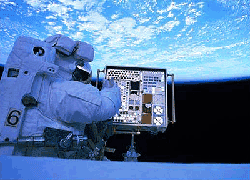Label Meets NASA Standards
- Published: April 01, 2010

A laser-engraved label from tesa tape, Charlotte, NC, was part of a Mission International Space Station Experiment (MISSE) by the National Aeronautics and Space Administration (NASA).
The experiment was designed to test the durability and readability of both human and machine-readable markings and part identifiers after being exposed to environmental elements of the low earth orbit environment for an extended time period.
To date, NASA has conducted several MISSE experiments, each one containing an array of marked and coded sample materials to be positioned on the exterior of the International Space Station for a defined period of time, and then removed and returned to earth to be inspected for readability. Each of the sample materials is exposed to harsh environmental conditions, including vacuums, solar ultraviolet radiation, micrometeoroids, space debris, atomic oxygen, and deep thermal cycles.
Prepare for Orbit
Working closely with NASA through one of tesa’s laser label customers, Sys-Tec Corp., Petersburg, MI, Dave Adams of tesa tape recommended a premier tesa labeling product for inclusion in the MISSE 6 Experiment. After gaining acceptance to the mission, the tesa Secure 6973 PV3 Laser Engraved Label was prepared for its first space mission.
Coded specimens, including the tesa Secure 6973 PV3 laser-engraved label, were photographed and placed on the exterior surface of the International Space Station. They remained in orbit for more than one year.
Upon retrieval from orbit, each specimen was photographed again and tested for readability using select reading devices. The tesa label was read successfully and now is considered one of the acceptable marking and coding methods for NASA.











